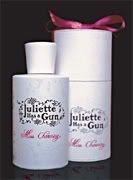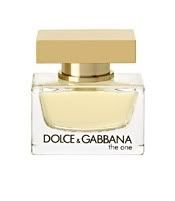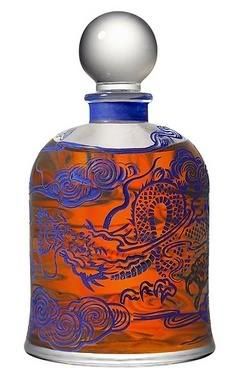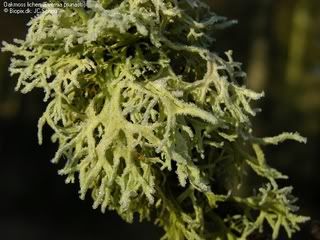
Scoop and pic via cosmeticnews


“Is it getting better?
Or do you feel the same?
Will it make it easier on you,
now you got someone to blame?”
No, no, I don’t blame anyone. It’s all good anyway.
Dolce & Gabbana have just come out with The One. A floral-oriental that they told us aimed to appeal to a “real diva, an object of desire, like the woman represented by Brazilian top model Gisèle Bündchen as seen through the lens of photographer Jean Baptiste Mondino”. In that regard the perfume is going for sensuality, presence, passion. As Osmoz bombastically states quoting the press release: “Every woman is The Woman: (…) You want her to be unique, ‘the one’: spectacular, joyful, ironic, strong and passionate, and always – indubitably – herself’.
Taking into account that D&G’s leitmotif is of a romantic inclination with interjections of “mama Italia” in Anna Magnani neorealistic style, it doesn’t surprise me that they have been quite successful. Their rich, mature and quite old-fashioned opulence that met with great success was named Pour Femme (codenamed “red cap”; reminds me of a Russian spy code or something in a bad B-movie about the Iron Curtain- practical though). Their smashing best-seller, especially in mediterranean countries, Light Blue turned my own personal lights blue from the ubiquity with which I encounter it on every single female of reproductive age come spring and summer. Sicily, their aldehydic soapiness of a sheer veil is getting discontinued I hear and it’s a pity, if only –as I never “got it”- because I won’t get to watch any longer the [[url=http://www.youtube.com/watch?v=P7YkgNbYb9g]]glorious b/w TV commercials of Giuseppe Tornatore [[/url]] (click to watch)featuring the succulent tormented beauty of widow Monica Belucci weeping for her dead husband; her old-fashioned slip laced with Sicily taken secretly away by a young admirer.
The rest of the Italian duo’s line includes the dependable virility of Pour Homme, the playfull By permutations (surely not with a sexually charged undercurrent, I hope) and the lighter, younger D&G line with feminine and masculine versions.
A new launch was needed and The One it was. Featuring the long maned Gisèle Bündchen, poster girl of picture-perfect sensuality in westernised standards, it promised to be diva-like. I can front out vouch for its un-diva, completely wearable and friendly character, nevertheless. Maybe the male dominating photographer [[url=http://grrrlcott.wordpress.com/2006/10/18/dolce-gabbana-the-one/]]in the ads [[/url]] is a pre-taste of its submissive character.
“Did I disappoint you?
Or leave a bad taste in your mouth?”
Assuredly not, honey. Just a taste of a déjà -vu. Just that.
Its great flaw, especially for something bearing such a moniker, is a lack of individuality, of uniqueness.
Oh, how I wish it were a case of
“Have you come here for forgiveness?
Have you come to raise the dead?
Have you come here to play Jesus?
To the lepers in your head…”
But it wasn’t meant to be The One to end all others. After all I have found my personal One long, long time ago and I fervently believe that perfumes, like books, like art, like love, choose us and not the other way around.
The bottle is a designing success: very austere and contemporary, a spare squatty affair with a gold geometrical cap to accompany the light gold of the jus inside. Substantial and no nonsense. Luxury without ostentatiousness. The official notes are: Mandarin, bergamot, litchi, peach, jasmine, lily, lily of the valley, plum, vetiver, amber, musk
The opening stage of The One emits tangy sweet fruitness of discernible bergamot and mandarin, accompanied by lactonic interlays of peach, rendering the top very fruity indeed. Lily is the dominating floral force during the middle phase of the journey on skin, with its sweetness balanced by the tartness of the fruits. Jasmine also makes an appearence, but interwoven with the other notes. No vetiver discernible to me in the base however, which is redolent of the nuzzling warmth of a sweet vanillic amber coupled to the softness of a clean slightly powdery musk of average lasting power.
The whole has an uncanny way of reminding me of the very pleasant but not earth-shattering quality of the thankfully slightly drier Cinema by Yves Saint Laurent, launched just 2 years prior to The One. Has short-term memory loss become so prevalent in everyday life that designers and noses are inspired not by legends of the past but by products of such a recent crop?
The One is tarter in the first stages and lacks the almondy flower note, but they then segue on to comparable pathways, a sort of “Elective Affinities” for those who are too fluffy to study Goethe in the first place.
And come to think of it, I prefer Cinema by an inch.
Perhaps as U2 would have said:
“I have kissed honey lips
Felt the healing in her fingertips
It burned like fire
this burning desire.
But I still haven’t found what I’m looking for”.
Nice try though, Dolce & Gabbana. And I mean this?
You can see the whole range [[url=http://www.mistrys.co.uk/dolce-gabbana-the-one-for-women-eau-de-parfum-natural-spray-p-1625.html]]here[[/url]]. Bottles of Eau de parfum come in 50 and 75ml versions, there is also a shower gel, deodorant spray and body lotion.
Pic comes from osmoz.com


"Oak moss extracts (e.g. absolute, resinoid, concrete, etc.) obtainedThis ascertains that it is not oakmoss that is the culprit here, but probably its combination with tree moss. The issue however puts a spin on the reformulation of certain perfumes. Since the rise of the controversy it has been suggested that a warning label on the box of the perfume stating those specific ingredients included (more on that will be the theme of another article) might be the saving grace for those well-respected, nay treasured formulae of yore, especially the historic Guerlain ones. Mitsouko and Parure were prime candidates for a sweeping metamorphosis that would leave them harmed beyond any recognition. Lots of others as well. The official line of Guerlain PR had been denial of any reformulation up to a certain point in time, while in the last couple of years they admitted that the whole commercial line would be re-vamped by the end of 2005 to conform to IFRA regulations. No matter what solution might be suggested the result is that some amount of reformulation has indeed taken place (for the record, some people were in favour of the inclusion of the potential allergens with a warning on the box; others were championing the idea of including them only in parfum concentration or in the boutique exclusives, an idea that frankly reeks of elitism to me).
from Evernia prunastri should not be used such that the level in consumer
products exceeds 0.1%. In the presence of tree moss extracts the level of oak
moss has to be reduced accordingly such that the total amount of both extracts
does not exceed 0.1% in the final product.
Furthermore, oak moss extracts
used in perfume compounds must not contain added tree moss. Tree moss contains
resin acids. The presence of resin acids can be detected by using a routine
analytical method available from IFRA*. However, traces of resin acids are
unavoidable in current commercial qualities of oak moss. As an interim standard,
these traces must not exceed 0.1% (1000 ppm) dehydroabietic acid (DHA).
This
recommendation is based on test data on the sensitising potential of oak moss
and tree moss extracts, their cross-reactivity and the absence of sensitisation
reactions when tested at 0.6%. In addition, it has been shown that oxidation
products of resin acids contribute to the sensitising potential. This adaptation
to the Standard aims at reducing exposure to resin acids, while waiting for the
final outcome of a current research program.”
According to industry rumours, Parfums Givenchy are scheduling the relaunch of many of their classic fragrances in limited editions to celebrate the house's 50th anniversary in 2007. Ultra elegant Hubert de Givenchy is no longer head of the house to rejoice, but I bet this would be good news all the same. In the last decade due to dubious launches, especially since the company was acquired by the LVMH Group, parfums Givenchy were seen as a poor relation to Christian Dior, Chanel and Yves Saint Laurent. The latest offering Ange ou Démon did not help in this regard, I'm afraid, although the reviews for Amarige Mariage are leaving some leeway of hope.
In this day and age the most prevalent products on Givenchy perfume counters and their best known perfumes for women are Ysatis, Amarige, Organza and Very Irrésistible. Recent attempts to spin a special yarn of quality resulting in the Harvest series of 2005 (issued however in 2006) for the above perfumes, highlighting the one pivotal flower in each of the compositions with an exceptional harvest of blooms for it -namely mimosa for Amarige, jasmine for Organza, and rose for Very Irrésistible- have met with some lovely results; my favourite out of those has been the Organza Jasmine Harvest, a trully deep floriental that is redolent of the jasmine bush. Ysatis Iris had preceeded them in 2004, but the marketing behind it did not focus on the wine-harvest connection, an aspect they have wisened up to.
In an effort to satisfy news-thristy department stores audiences the house has become tired and full of "flankers"; industry name for perfumes that follow in the wake of a previous successful release capitalising on the name and exposure of the original in order to generate more interest in the brand. Such a case it proved to be for Insensé Ultramarine (1994) Xeryus rouge (1995), Extravagance d'Amarige (1998), Amarige d'Amour (2002) , Hot Couture white collection (2001), My Couture (2002), Pi Fraîche (2001), Insensé Ultramarine Ocean spirits series for men (2002), Insensé for her (2004), Insensé ultramarine beach in Boy and Girl versions(2006) and countless others. All in all a staggering 61 perfumes in as much as 49 years, of which only 9 were issued in the first 30 years of the house's history!! That means 52 launches in the last 15 years!! (if we consider the fact that Amarige was the 10th, launched in 1991). Think about it. It's preposterous.
Many of those did not even register, not making one tiny bleep on the radar, which is quite natural when one is faced with such a wide selection of fumes to choose from. The mind boggles and the nose stops to function properly at some point. Not to mention that a perfume counter can accomodate only so many bottles before it looks like a bad case of a discount warehouse.
The most interesting and unique offerings yet have been discontinued or are very hard to find: Givenchy Gentleman, a sturdy leather/patchouli woody of 1974, and Organza Indecence of 1999, a deep cinnamon vanillic composition that proved very popular in the US, and of course the citrusy classic Monsieur de Givenchy of 1959, the one which was kept into production because it was mr.Hubert's personal scent, are all such cases. However such chic classics as the originalAudrey Hepburn favourite L'interdit (=the forbidden), a violet laced aldehydic floral from 1957 for a most elegant lady, Givenchy III a chypre of the most noble character coming out in 1970, and the even more elusive clean, aldehydic hesperidic Le De Givenchy (issued in 1957 -same year as L'interdit; something unheard of the time- and also linked to Audrey) are set to be among the new relaunches. Supposedly keeping the original formulae and issued as limited editions for fans and collectors, this is both an admirable task as well as a difficult one, what with the scarcity of certain ingredients and the lack of the bases of yesteryear. Hope springs eternal however and I can't find it in my heart to bypass such an effort. Let's see what happens.
The first to see the light of day is the original L'interdit, following its reformulation a couple of years ago which left its fans in rapt disillusionement (and yes, the oxymoron is intentional). It will be available next August. Hurray for Givenchy fans and hopefully a new begining for a house that seemed disoriented for quite some time.
Pic depicting Audrey Heburn and Hubert de Givenchy comes from Audrey1.com
Next post will be about a thorny subject in perfume making.